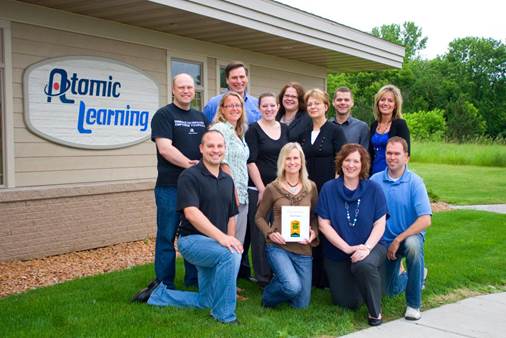With not enough hours in the day to teach,
let alone satisfy the Common core requirements, it’s hard for teachers to keep
up with two major demands on their time – taking on more professional
development and learning emerging and existing technology. Enter Atomic
Learning. With its 55,000 tutorials on 250 applications, teachers can quickly
and easily stay current on both.

Atomic
Learning with its 55,000 tutorials on 250 applications, teachers can quickly
and easily stay current on both
Quality and Effectiveness: Atomic Learning (AL)’s tutorials are designed to answer questions
as briefly and concretely as possible. Running times range from 3 to 5 minutes,
with many tutorials running under 2 minutes. If you miss something the first
time, catching up is easy. The tutorials offer step-by-step instructions and a
playlist of available clips that allows users to choose just the ones they
want. For example, in iMovie, you can go from the basics of getting started to the
technical details of trimming audio clips to creating video effects. Plus, if
there’s something not covered, you can ask a member of the AL online support
staff, and an answer will be emailed to you.

If
there’s something not covered, you can ask a member of the AL online support
staff, and an answer will be emailed to you.
Ease of Use:
With AL’s new interface, searching and customizing content is easy. Everything
is accessible from the home page. Users can find answers to tech questions,
browse available trainings and projects, learn and apply 21st-century
skills, concepts, and themes to the classroom, and keep track of individual
training. Need a quick brush-up? Just enter a specific question or keyword and
choose your applications. Results can be filtered by version and platform and
saved for future searches. Teachers wishing to align their curriculum with the
Common Core standards can be browse trainings by subject, state standards, or
ISTE NETS-S.

AL
shows teachers how to apply it with comprehensive, adaptable tech-integration
projects and new, 21st-century, theme-specific projects
Creative Use of Technology: Atomic Learning’s biggest asset is its ability to break down
technical information into manageable, easily digested bites using clear
narration and simple, yet precise, animation to answer specific questions,
while it’s important to understand the technology, AL shows teachers how to
apply it with comprehensive, adaptable tech-integration projects and new, 21st-century,
theme-specific projects. All tutorials are available in Flash or QuickTime and
can be closed-captioned. Many are also available in Spanish. For PD on the go,
AL is now on the iPad as a free download for members.
Suitability for Use in a School
Environment: AL is also a powerful tool for
administrators, who can assign staff trainings, track results, and create
reports. It also helps technology directors gauge professional development
needs at both the site and the district level. While access to administrative
tools is based on individual permission levels, teachers with access can also
assign tutorial and projects to their classes, give due dates, and track
students’ progress in e-portfolios. Teachers can also assign tutorials to
themselves and mark the most useful as favorites. As a plus, teachers can earn
grad credits by completing workshops and projects through Atomic Learning’s
partnership with Learner’s Edge and Augustana College.